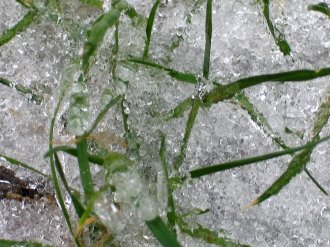My Turf’s on Ice
This podcast details the importance of keeping traffic off of frost or ice-covered turf, what kind of damage to expect, and how long the damage will likely persist.

Winter weather normally does not allow for a lot of discussion regarding topics for our lawns, but I did get an excellent question recently from a gentleman that thought his neighbor was being either incredibly vain or paranoid (maybe both) regarding his efforts to keep people off his tall fescue lawn when there was frost or ice on the turf. I had to laugh because I had just gone through the same discussion myself with my kids during severe winter freeze events in southwest Virginia.
Most early-rising golfers in the mid-Atlantic have experienced “frost delays” at the golf course in early spring or late fall. These delays are intended to prevent damage to the playing surface that would be caused by either foot or cart traffic. The neighbor that was out to protect his lawn was applying the same principle.
Trafficking frost or ice-covered turf usually results in extensive physical “breaking” of the leaves. The internal pipelines of the leaves (the xylem and phloem tissues that are involved in moving water, nutrients, and carbohydrates around in the plant) are usually severed when traffic is applied to ice-covered foliage. The damaged turf leaves don’t fall away completely from the stem, but instead slowly turn brown and die.
You will likely see visible damage from the traffic (in the form of footprints, paw prints from pets or wild animals, etc.) within a few days and the evidence of the trafficked turf will remain for several weeks until new leaves form later in the spring. For those of us with cool-season grasses that can mean living with the damage well into April or May. The good news is that the damage is primarily cosmetic and does not impact the overall survival of your lawn.
What about traffic and snow cover—any concerns here? Sure, repeated sledding over an area is imparting some wear and compaction to that part of the lawn, but the damage is usually not as acute as seen with traffic on frost or ice-covered turf. It’s just human nature: a couple of inches of snow anywhere near a hillside and somebody is going to pay you a visit with a sled. So get out there with the kids and enjoy a good snow event with a clear conscience in regards to your lawn.
About this File
Author: Mike Goatley
Release Date: January 7, 2010
Length: 02:31
Link: My Turf’s on Ice
Contact Turf and Garden Tips
Please contact your local Extension office for more information related to your turf and garden questions.


